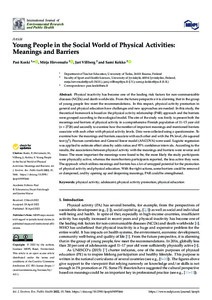Young People in the Social World of Physical Activities: Meanings and Barriers
Koski Pasi; Villberg Jari; Hirvensalo Mirja; Kokko Sami
https://urn.fi/URN:NBN:fi-fe2022081155092
Tiivistelmä
Physical inactivity has become one of the leading risk factors for non-communicable diseases (NCDs) and death worldwide. From the future perspective it is alarming that in the group of young people few meet the recommendations. In this respect, physical activity promotion in general and physical education have challenges and new approaches are needed. In this study, the theoretical framework is based on the physical activity relationship (PAR) approach and the barriers were grouped according to the ecological model. The aim of the study was firstly to present both the meanings and barriers of physical activity in a comprehensive Finnish population of 11-15 year old (n = 2728) and secondly to examine how the number of important meanings and mentioned barriers associate with each other with physical activity levels. Data were collected using a questionnaire. To examine how the meanings and barriers associate with each other and with the PA level, chi-squared test (χ2), Pearson correlation and General linear model (ANCOVA) were used. Logistic regression was applied to estimate effect sizes by odds ratios and 95% confidence intervals. According to the results, the associations between physical activity with the meanings and barriers were reverse and linear. The more important the meanings were found to be, the more likely the study participants were physically active, whereas the more barriers participants reported, the less active they were. The approach which utilizes meanings and barriers has a lot of untapped potential for the promotion of physical activity and physical education. With the right actions, some barriers could be removed or dampened, and by opening up and deepening meanings, PAR could be strengthened.
Kokoelmat
- Rinnakkaistallenteet [19207]
